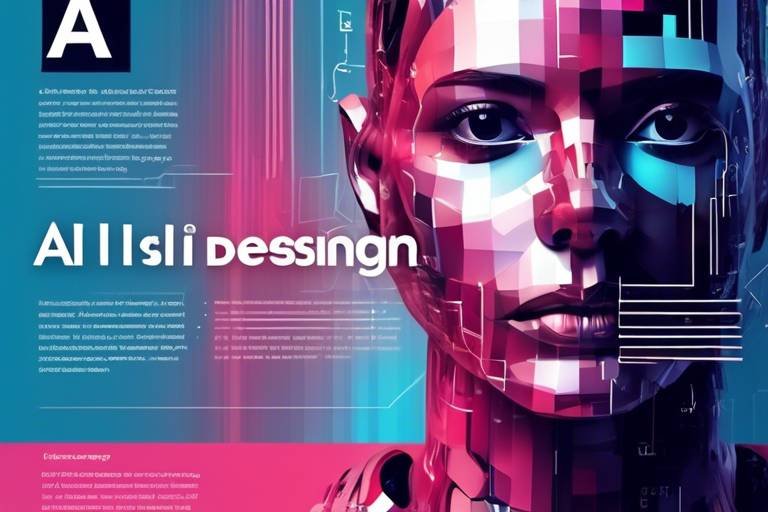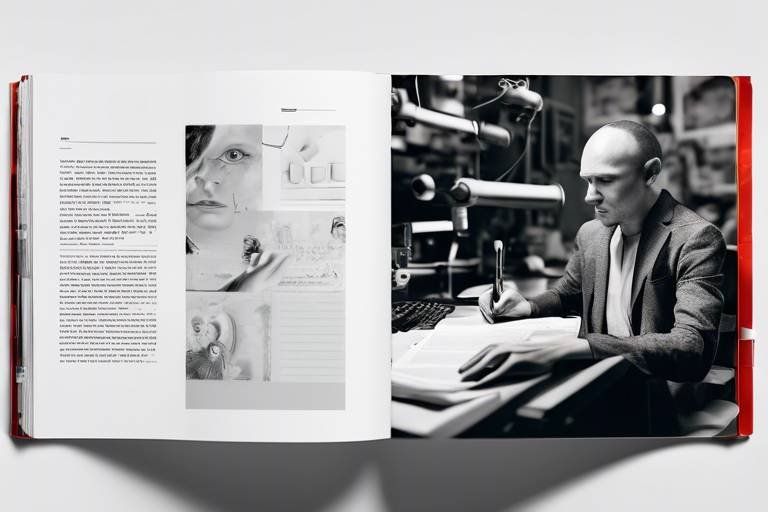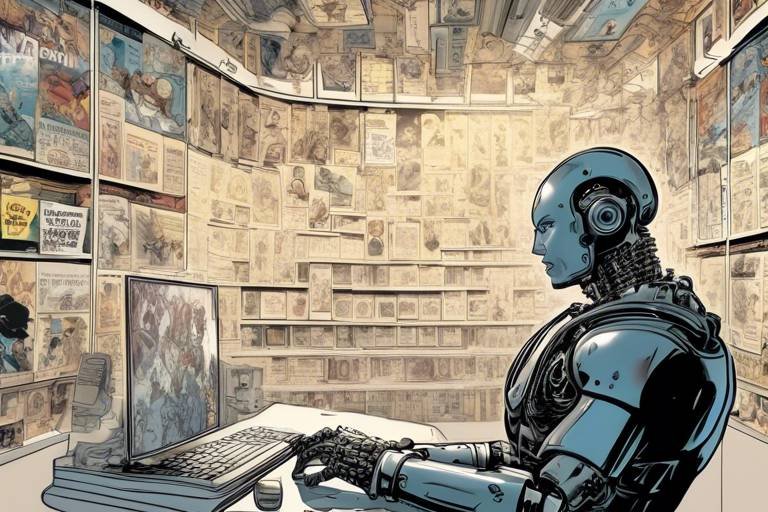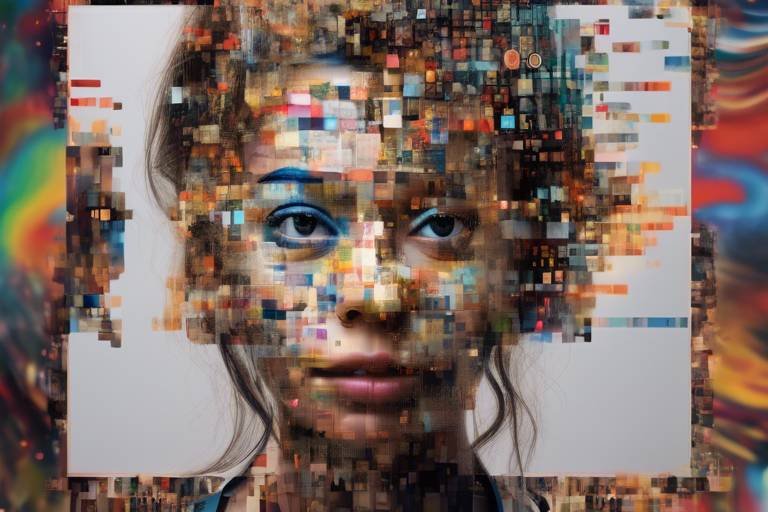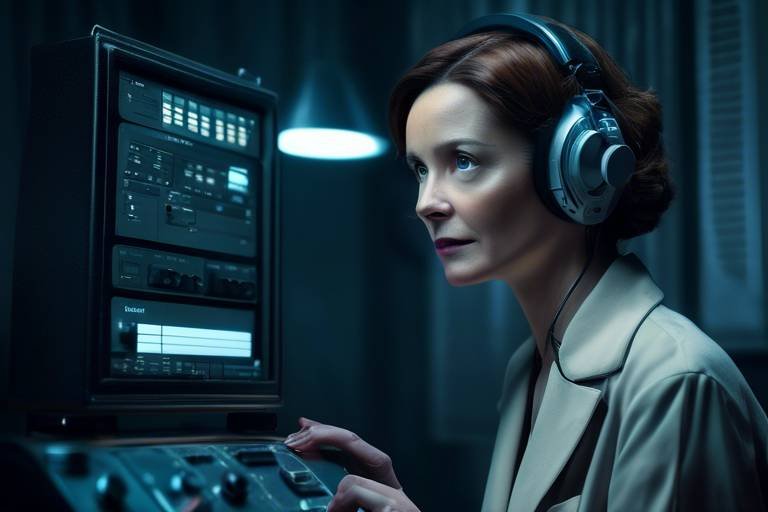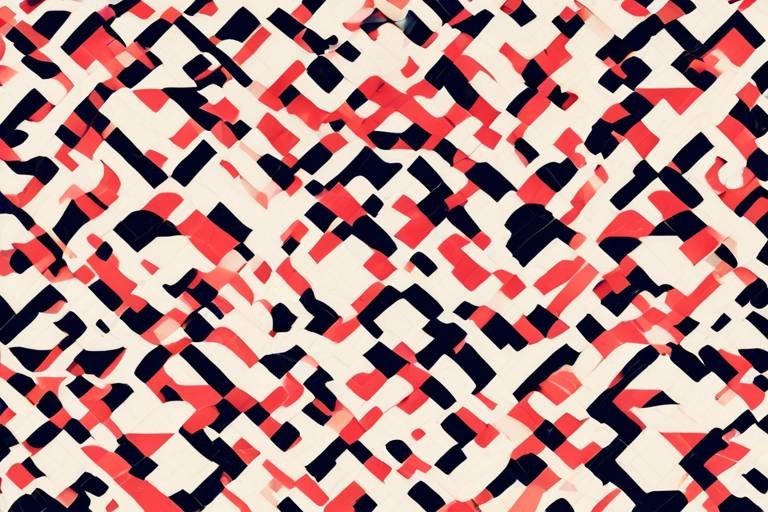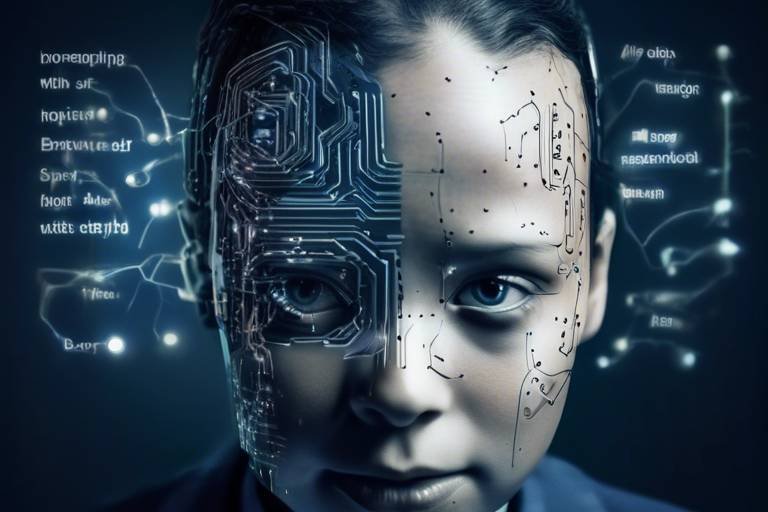Building Dreams: AI in Interior Design
In today's fast-paced world, the fusion of technology and creativity has never been more pronounced, especially in the realm of interior design. Artificial Intelligence (AI) is not just a buzzword; it’s a revolutionary force that is reshaping how we conceptualize and execute design projects. Imagine walking into a space that feels like it was tailor-made just for you, where every color, texture, and layout resonates with your personality. This is the magic of AI in interior design, and it’s transforming dreams into reality.
AI is stepping in as a powerful ally for designers, providing tools that enhance creativity, streamline processes, and ensure that the final output aligns with clients' visions. Think of AI as a modern-day architect's assistant—an intelligent partner that can sift through mountains of data, analyze trends, and suggest innovative solutions that a human mind alone might overlook. With its ability to learn and adapt, AI is not merely a tool; it’s a catalyst for creativity that invites designers to push boundaries and explore new horizons.
As we delve deeper into the world of AI in interior design, we will uncover how it enhances the design process, personalizes spaces, and optimizes project management. The implications are profound—not only for designers but also for clients who seek spaces that reflect their unique identities and lifestyles. Get ready to explore how this technological marvel is revolutionizing the way we think about and create interior environments.
One of the most exciting aspects of AI in interior design is the emergence of AI-powered design tools. These software solutions are revolutionizing the way designers approach their work. Imagine having a virtual assistant that can generate design concepts based on your preferences in seconds! With AI-driven design software, designers can create, visualize, and modify designs with unprecedented speed and accuracy.
These tools leverage algorithms to analyze vast amounts of data, enabling designers to access a treasure trove of inspiration and ideas. For instance, when working on a new project, a designer can input specific parameters—such as room dimensions, color preferences, and style influences—and the AI can generate multiple design options in a matter of moments. It’s like having a brainstorming session with a team of experts, but without the time constraints!
One of the standout features of AI in interior design is its ability to offer personalization that feels genuinely unique. By analyzing user preferences and behaviors, AI algorithms can provide tailored design recommendations that resonate with individual personalities. This means that spaces can be crafted not just to look good but to feel like home.
Imagine a scenario where a designer is tasked with creating a living room for a client who loves nature. AI can analyze the client's past choices, social media activity, and even their shopping habits to suggest elements such as color palettes inspired by natural landscapes, furniture that incorporates organic shapes, and decor that reflects a love for the outdoors. The result? A space that feels like a personal sanctuary.
AI's power lies in its ability to harness data-driven insights. Designers can make informed decisions based on real-time trends and user feedback, allowing them to stay ahead of the curve. For instance, if a particular color is trending in the design world, AI can alert designers, ensuring that their projects remain relevant and appealing.
Moreover, AI can predict future design trends by analyzing data from various sources, including social media, design publications, and consumer behavior. This predictive capability helps designers anticipate what clients will want in the future, allowing them to create spaces that are not only current but also forward-thinking.
Effective communication is crucial in the design process. AI enhances client interaction by streamlining feedback processes and ensuring that designs align with client visions. With AI tools, clients can visualize their spaces in real-time, making it easier for them to provide feedback and make decisions. This collaborative approach not only saves time but also fosters a sense of partnership between designers and clients.
The integration of AI with virtual reality (VR) is another game-changer. Clients can immerse themselves in a virtual environment, experiencing their designs before making any commitments. This immersive technology allows clients to walk through their spaces, visualize color schemes, and even rearrange furniture, all from the comfort of their homes. It’s like having a sneak peek into their future living space!
Beyond creativity, AI is also optimizing project management in interior design. From scheduling to resource allocation, AI ensures timely and cost-effective project completion. Imagine a world where project timelines are streamlined, and budgets are adhered to without the usual hiccups. AI makes this possible by analyzing project data and providing insights that help designers make informed decisions.
Automation tools powered by AI simplify repetitive tasks, allowing designers to focus on what they do best—being creative. By automating tasks like inventory management, scheduling meetings, and generating reports, designers can dedicate more time to brainstorming and innovating. It’s like having a personal assistant who takes care of the nitty-gritty while you focus on building dreams.
AI also fosters better collaboration among design teams. Shared platforms and tools enhance communication, ensuring that everyone is on the same page. This synergy leads to more cohesive designs and smoother project execution. When teams work together seamlessly, the results are nothing short of spectacular.
While the benefits of AI in interior design are undeniable, it’s essential to acknowledge the challenges and limitations that come with its integration. One significant concern is the potential loss of the human touch in design processes. As AI takes on more responsibilities, the debate continues about how to balance technology with creativity.
Design is inherently a creative discipline, and while AI can enhance efficiency, it cannot replicate the emotional and intuitive aspects of human creativity. The challenge lies in finding a harmonious balance where technology supports designers without overshadowing their unique artistic vision. After all, design is not just about aesthetics; it’s about storytelling and evoking emotions.
Another critical aspect to consider is the ethical implications of using AI in design. Issues such as data privacy and the potential for bias in algorithm-driven recommendations raise important questions. Designers must navigate these challenges carefully to ensure that their use of AI aligns with ethical standards and respects client confidentiality.
- How does AI improve creativity in interior design? AI enhances creativity by providing designers with data-driven insights and generating design options that inspire new ideas.
- Can AI replace human designers? While AI can assist in many tasks, it cannot replace the emotional and intuitive aspects of human creativity that are essential in design.
- What are the ethical concerns associated with AI in design? Ethical concerns include data privacy, potential bias in recommendations, and the need to balance technology with human creativity.
- How does virtual reality enhance the client experience? Virtual reality allows clients to immerse themselves in their designs, providing a realistic preview of their spaces before final decisions are made.

AI-Powered Design Tools
Imagine stepping into a world where your interior design dreams come to life at the click of a button. are doing just that, transforming the way designers approach their craft. These innovative software solutions leverage the power of artificial intelligence to streamline the design process, making it not just easier but also far more exciting. With features that enhance creativity and provide tailored solutions to clients, these tools are revolutionizing the industry.
One of the most exciting aspects of AI in interior design is its ability to analyze vast amounts of data. This means that designers can access insights that were once buried under piles of paperwork and sketches. For instance, AI algorithms can sift through countless design styles, color palettes, and spatial arrangements to suggest the most suitable options based on current trends and individual client preferences. This not only speeds up the design process but also opens up a realm of creative possibilities that were previously unimaginable.
Imagine you’re a designer working on a new project. You input your client's preferences and the AI tool swiftly generates a variety of design options, each tailored to their unique taste. This level of customization is a game-changer. Designers can now present clients with a range of ideas that resonate with their vision, allowing for a more collaborative and satisfying design experience. But how do these tools actually work? Let’s break it down:
| Feature | Description |
|---|---|
| Style Recognition | AI analyzes existing designs to identify styles that align with user preferences. |
| Color Matching | Suggests color combinations based on psychological effects and current trends. |
| Space Optimization | Utilizes algorithms to recommend layouts that maximize space efficiency. |
| Material Suggestions | Recommends materials based on durability, aesthetics, and budget considerations. |
These AI-powered tools not only enhance the creative process but also improve efficiency. Designers can spend less time on mundane tasks like drafting and more time on what truly matters: bringing their creative visions to life. Furthermore, the integration of AI into design software allows for real-time adjustments, meaning clients can see changes immediately and provide instant feedback. This dynamic interaction fosters a sense of collaboration that was once limited to face-to-face meetings.
However, it's essential to remember that while AI can enhance creativity, it does not replace the human touch. The best designs often come from a blend of technology and human intuition. Designers still play a crucial role in interpreting the data and translating it into a cohesive vision that resonates with clients. In essence, AI serves as a powerful assistant, amplifying the designer's capabilities rather than overshadowing them.
As we continue to explore the capabilities of AI in interior design, one thing is clear: these tools are not just a trend; they are the future of the industry. With the potential to unlock new levels of creativity and efficiency, AI-powered design tools are paving the way for a more innovative and personalized approach to interior design. So, are you ready to embrace this technological revolution and elevate your design game?

Personalization Through AI
In today's fast-paced world, where individuality is celebrated, personalization has become a cornerstone of interior design. Imagine walking into a space that feels like it was crafted just for you, reflecting your tastes, preferences, and lifestyle. This is where artificial intelligence comes into play, enabling designers to create customized environments that resonate deeply with clients. By analyzing user preferences and behaviors, AI algorithms can offer tailored design recommendations that transform generic spaces into personalized havens.
One of the most fascinating aspects of AI in interior design is its ability to synthesize vast amounts of data to understand what makes a space truly unique. For instance, AI can analyze factors such as color preferences, furniture styles, and even the emotional responses of individuals to different environments. This data-driven approach allows designers to create spaces that not only look good but also feel right. Imagine a home where every room tells a story about the people who live there, thanks to insights drawn from their interactions with various design elements.
Moreover, AI-driven design tools can provide a level of customization that was previously unimaginable. When a client expresses a desire for a particular aesthetic, AI can quickly sift through countless design options, presenting the most relevant choices tailored to that individual's style. This process not only saves time but also enhances the overall design experience. With AI, designers can offer clients a curated selection of options that align with their vision, making the decision-making process smoother and more enjoyable.
To illustrate this point, consider the following table that highlights how AI personalizes various aspects of interior design:
| Aspect | AI Contribution |
|---|---|
| Color Selection | Analyzes user preferences to suggest color palettes that evoke desired emotions. |
| Furniture Arrangement | Utilizes spatial data to recommend layouts that maximize functionality and flow. |
| Material Choices | Identifies sustainable materials based on user values and environmental impact. |
| Lighting Design | Suggests lighting solutions that enhance mood and highlight design features. |
As we delve deeper into the realm of AI in interior design, it becomes clear that this technology is not just a tool but a partner in the creative process. By leveraging AI, designers can enhance their understanding of client preferences, leading to more meaningful and engaging spaces. Imagine the joy of walking into a room that feels like an extension of your personality, where every detail has been thoughtfully curated just for you. This is the magic of AI-driven personalization in interior design, making it a game-changer in how we experience our environments.
In conclusion, as we embrace the future of design, the role of AI in personalizing spaces will only continue to grow. It's not about replacing the human touch; rather, it's about augmenting our capabilities to create environments that truly resonate with who we are. So, the next time you step into a beautifully designed room, remember that AI might just be behind the scenes, helping to craft a space that feels like home.
- How does AI personalize interior design? AI analyzes user data to provide tailored design recommendations based on individual preferences and behaviors.
- Can AI replace human designers? While AI enhances the design process, it complements human creativity rather than replaces it.
- What are the benefits of using AI in design? AI improves efficiency, provides data-driven insights, and enhances personalization, leading to more satisfying design outcomes.

Data-Driven Insights
In the fast-paced world of interior design, the ability to make informed decisions can mean the difference between a project that dazzles and one that disappoints. This is where come into play, powered by the incredible capabilities of artificial intelligence. Imagine having a personal assistant that not only understands your design preferences but also analyzes vast amounts of data to provide you with tailored recommendations. This is precisely what AI does, transforming the way designers approach their projects.
AI utilizes data analytics to assess trends, user behaviors, and preferences, enabling designers to make choices grounded in solid evidence rather than mere intuition. For instance, by examining previous projects and client feedback, AI can identify which colors, materials, and layouts resonate most with specific demographics. This means that designers can create spaces that are not only visually appealing but also aligned with the desires and needs of their clients.
Furthermore, AI can aggregate data from various sources, including social media, market research, and design platforms, to provide insights that are both comprehensive and up-to-date. Designers can then leverage this information to anticipate client needs and preferences, ensuring that their creations are not just trendy but also timeless. The ability to predict what will be popular in the near future is invaluable, as it allows designers to stay one step ahead of the competition.
To illustrate the impact of data-driven insights, consider the following table that outlines how AI enhances decision-making in interior design:
| Aspect | Traditional Approach | AI-Driven Approach |
|---|---|---|
| Client Preferences | Based on previous experience and intuition | Analyzed through data patterns and client feedback |
| Trend Analysis | Manual research and observation | Automated analysis of social media and design trends |
| Design Choices | Subjective decision-making | Data-backed recommendations |
| Project Outcomes | Variable success rates | Higher satisfaction through tailored designs |
Ultimately, the integration of AI into the design process allows for a more holistic understanding of what works and what doesn’t. Designers can harness these insights to create spaces that are not only functional but also deeply personal, reflecting the unique tastes and lifestyles of their clients. It's like having a crystal ball that reveals not just the present, but also the future of design, making the creative process more exciting and impactful.
- How does AI improve decision-making in interior design?
AI analyzes large datasets to provide insights into client preferences, trends, and successful design choices, helping designers make informed decisions. - Can AI predict future design trends?
Yes, AI uses historical data and current market analysis to forecast future trends, allowing designers to stay ahead of the curve. - What are the ethical implications of using AI in design?
There are concerns about data privacy and potential biases in AI recommendations, which require careful consideration and ethical guidelines.

Predictive Design Trends
In the ever-evolving world of interior design, staying ahead of the curve is crucial for success. With the integration of artificial intelligence, designers are now equipped with powerful tools that can predict future design trends. But how does this process work? Imagine having a crystal ball that not only shows you what colors and styles will dominate the market next season but also provides insights into the preferences of your target audience. That's the magic of AI in predictive design.
AI algorithms analyze vast amounts of data from various sources, such as social media, design publications, and consumer behavior patterns. By sifting through this information, AI can identify emerging trends and forecast what will resonate with clients. For instance, if there’s a surge in posts about sustainable materials on Instagram, AI can alert designers to incorporate eco-friendly options into their projects, ensuring they meet the growing demand for sustainability.
Moreover, the predictive capabilities of AI extend beyond mere aesthetics. They can help designers understand the **functional needs** of spaces based on demographic data. For example, if a neighborhood is becoming increasingly popular among young families, AI might suggest designs that emphasize open spaces, safety features, and playful elements. This level of insight allows designers to create spaces that are not only visually appealing but also highly functional and relevant to the intended users.
To illustrate the impact of predictive design trends, consider the following table that showcases some recent predictions made by AI tools in the interior design industry:
| Trend | Predicted Year | Key Features |
|---|---|---|
| Biophilic Design | 2024 | Natural materials, indoor plants, and natural light |
| Smart Home Integration | 2025 | Automated lighting, smart thermostats, and voice-controlled devices |
| Sustainable Materials | 2026 | Recycled, upcycled, and locally sourced materials |
With these insights, designers can proactively adapt their strategies, ensuring that their creations resonate with current and future market demands. This is not just about following trends; it's about creating spaces that tell a story and reflect the lifestyles of their inhabitants. By leveraging AI's predictive capabilities, interior designers can enhance their creativity and deliver projects that are not only beautiful but also relevant and meaningful.
In conclusion, the role of AI in predicting design trends is a game-changer for the interior design industry. It empowers designers to make informed decisions, stay ahead of trends, and ultimately create spaces that exceed client expectations. As we look to the future, the collaboration between human creativity and AI technology will undoubtedly lead to even more innovative and exciting design possibilities.
- How does AI predict design trends?
AI analyzes data from various sources, including social media and consumer behavior, to identify emerging trends. - Can AI replace human designers?
No, AI serves as a tool to enhance the creative process, but human intuition and creativity remain irreplaceable. - What are some examples of predictive design trends?
Examples include biophilic design, smart home integration, and the use of sustainable materials.

Client Interaction Enhancements
In the ever-evolving world of interior design, client interaction has undergone a remarkable transformation, thanks to the integration of artificial intelligence (AI). Imagine walking into a design firm where the initial consultation feels more like a conversation with a friend than a formal meeting. With AI, this is becoming a reality. By leveraging sophisticated algorithms and machine learning, designers can now facilitate a more personalized and engaging dialogue with their clients.
One of the most exciting enhancements AI brings to client interactions is the ability to gather and analyze feedback in real time. Traditional methods often involved lengthy surveys or follow-up meetings, which could lead to miscommunication or delays in the design process. Now, AI tools can instantly analyze client preferences and sentiments, allowing designers to adjust their proposals on the fly. This not only saves time but also ensures that the designs align closely with the client's vision.
Moreover, AI-powered chatbots are stepping in as virtual assistants, available 24/7 to address client inquiries and provide updates on project progress. These chatbots can handle a range of tasks, from answering basic questions about design choices to scheduling appointments. Imagine a client who has a sudden inspiration at midnight; instead of waiting for the next business day, they can interact with a chatbot that understands their needs and preferences, providing instant feedback and suggestions.
To further enhance the client experience, many designers are incorporating AI-driven visualization tools. These tools allow clients to see a realistic representation of their space before any physical work begins. For instance, using augmented reality (AR), clients can visualize how different color palettes or furniture arrangements will look in their homes. This immersive experience not only boosts client confidence in the design choices but also fosters a collaborative atmosphere where their input is valued and actively integrated into the design process.
However, it's important to remember that while AI enhances communication, the human touch remains irreplaceable. Designers must strike a balance between utilizing AI for efficiency and maintaining personal connections with clients. After all, interior design is not just about aesthetics; it's about creating spaces that resonate with the personalities and lifestyles of the individuals who inhabit them.
In conclusion, the integration of AI into client interactions is revolutionizing the interior design industry. By streamlining communication, providing instant feedback, and enhancing visualization, AI is empowering designers to create spaces that are not only beautiful but also deeply personal. As we move forward, the challenge will be to harness these technological advancements while preserving the essential human elements that make design a truly collaborative art form.
- How does AI improve communication with clients in interior design? AI enhances communication by providing real-time feedback and utilizing chatbots for instant responses to client inquiries.
- Can AI predict client preferences? Yes, AI algorithms analyze past behaviors and preferences to offer tailored design recommendations.
- What role does virtual reality play in client interactions? Virtual reality allows clients to visualize designs in immersive environments, enhancing their understanding and engagement with the design process.
- Are there any risks associated with using AI in design? Yes, there are ethical considerations, including data privacy and the potential for bias in AI algorithms.

Virtual Reality Integration
Imagine stepping into a room that you’ve only seen in blueprints or 3D models—sounds incredible, right? This is the magic of Virtual Reality (VR) in interior design. By integrating AI with VR technology, designers can create immersive environments that allow clients to experience their future spaces before any physical work begins. This transformative approach not only enhances the design process but also elevates client satisfaction to unprecedented levels.
With VR, the traditional design review process has undergone a radical change. Instead of merely presenting flat images or 2D plans, designers can now take clients on a virtual tour of their proposed designs. This immersive experience allows clients to visualize spaces in a way that feels real, making it easier for them to provide feedback and make decisions. Imagine walking through a living room, feeling the layout, and seeing how the lighting interacts with the colors on the walls—all without lifting a paintbrush or moving a single piece of furniture!
Moreover, VR integration allows for real-time adjustments. If a client feels that the sofa is too large or the color scheme isn’t quite right, designers can make instant modifications in the virtual space. This not only saves time but also ensures that the final design aligns perfectly with the client’s vision. The ability to manipulate design elements on the fly fosters a collaborative atmosphere, where clients feel more involved in the creative process.
To illustrate the impact of VR in interior design, consider the following table showcasing key benefits:
| Benefit | Description |
|---|---|
| Enhanced Visualization | Clients can see and experience designs in a realistic setting, making it easier to understand spatial relationships. |
| Immediate Feedback | Real-time adjustments can be made based on client input, streamlining the design process. |
| Increased Engagement | Clients are more likely to feel invested in the project when they can interact with the design in a meaningful way. |
| Cost Efficiency | Identifying design flaws early in the process can save time and resources, reducing costly revisions later. |
As we move forward, the integration of AI and VR is poised to reshape the interior design landscape. With these technologies, designers can push the boundaries of creativity while ensuring that client preferences are at the forefront of every project. This synergy not only enhances the design experience but also builds stronger relationships between designers and clients, fostering a sense of trust and collaboration.
In conclusion, the fusion of AI and virtual reality represents a new frontier in interior design. It empowers designers to create spaces that are not only aesthetically pleasing but also deeply personal and functional. As we embrace these innovations, we can look forward to a future where designing our dream spaces becomes an engaging and interactive journey.
- What is the role of AI in interior design? AI enhances creativity, efficiency, and personalization in the design process.
- How does virtual reality improve client interactions? VR allows clients to experience designs in immersive environments, facilitating better feedback and collaboration.
- Are there any challenges with using AI in design? Yes, challenges include balancing technology with human creativity and addressing ethical considerations.

Efficiency in Project Management
In the fast-paced world of interior design, efficiency is not just a buzzword; it's a necessity. With the integration of artificial intelligence (AI), project management has taken a transformative leap, redefining how designers approach their workflows. Imagine a world where tedious tasks are automated, allowing creative minds to focus on what they do best—crafting stunning spaces. AI tools streamline processes, manage schedules, and allocate resources, ensuring that projects are completed on time and within budget.
One of the standout features of AI in project management is its ability to analyze vast amounts of data and provide actionable insights. For instance, AI can forecast potential delays by examining historical project timelines and identifying bottlenecks. This predictive capability empowers designers to proactively address issues before they escalate, making the entire project flow smoother. In fact, studies have shown that design teams utilizing AI-driven project management tools can reduce project completion times by up to 30%.
Additionally, AI enhances communication among team members. With shared platforms that utilize AI algorithms, designers can collaborate seamlessly, sharing ideas and feedback in real-time. Imagine a scenario where a designer in New York can effortlessly connect with a client in London or a contractor in Tokyo, all while viewing the same digital design model. This global connectivity not only speeds up decision-making but also enriches the creative process through diverse perspectives.
Moreover, AI tools can automate repetitive tasks, such as scheduling meetings or tracking project milestones. This automation frees up valuable time for designers, enabling them to engage in more creative activities. For example, instead of spending hours manually updating project timelines, designers can rely on AI to track progress and send reminders, allowing them to dedicate their efforts to brainstorming innovative design concepts.
However, it's essential to note that while AI significantly boosts efficiency, it doesn't replace the human touch that is crucial in interior design. The balance between leveraging technology and maintaining creative intuition is vital. Designers must still bring their unique perspectives and emotional intelligence into the mix, ensuring that the final designs resonate with clients on a personal level.
In summary, the efficiency brought about by AI in project management is a game-changer for interior design. By automating mundane tasks, enhancing communication, and providing data-driven insights, AI allows designers to focus on what truly matters: creating beautiful, functional spaces that reflect their clients' visions. As we move forward, embracing this technology will not only streamline processes but also elevate the artistry of design.
- How does AI improve project management efficiency?
AI enhances efficiency by automating repetitive tasks, analyzing data for predictive insights, and improving communication among team members. - Can AI replace human creativity in interior design?
No, AI is a tool that assists in the design process but cannot replicate the unique human touch and emotional intelligence that designers bring to their work. - What are the benefits of using AI in interior design?
Benefits include faster project completion, improved collaboration, data-driven decision-making, and the ability to focus more on creativity.

Automated Workflow Solutions
In the fast-paced world of interior design, time is of the essence. Designers often juggle multiple projects, client meetings, and creative brainstorming sessions all at once. This is where powered by artificial intelligence come into play, acting as a game-changer for the industry. Imagine having a personal assistant that not only organizes your tasks but also learns your preferences and optimizes your workflow to maximize productivity. Sounds like a dream, right? Well, it’s becoming a reality!
AI-driven tools can automate a plethora of repetitive tasks that typically consume a designer's valuable time. From scheduling meetings to managing invoices, AI can handle it all, allowing designers to channel their energy into what they do best: creating stunning spaces. For instance, software can automatically generate project timelines based on deadlines, resources, and client availability, ensuring that everyone is on the same page. This not only minimizes the risk of miscommunication but also enhances accountability among team members.
Furthermore, these automated systems can help in tracking project progress in real-time. Imagine being able to see updates on your project’s status at a glance, without having to sift through endless email threads or spreadsheets. AI tools can provide dashboards that display key performance indicators, budget tracking, and resource allocation, making it easier for designers to make informed decisions quickly. This is akin to having a navigation system that shows you the best route to your destination, adjusting in real-time to traffic conditions.
Moreover, the integration of AI in workflow solutions fosters better collaboration among team members. With shared platforms that allow for real-time updates and feedback, designers, architects, and clients can work together seamlessly. For example, when a designer makes a change to a layout, everyone involved is notified instantly, ensuring that all parties are aligned. This level of transparency not only enhances teamwork but also strengthens client relationships, as clients feel more engaged in the design process.
However, while these automated solutions offer remarkable benefits, it’s essential to remember that they work best as a complement to human creativity. The unique vision and artistic flair that a designer brings to a project cannot be replicated by AI. Instead, think of AI as a powerful tool that enhances the designer’s capabilities, allowing them to focus on innovation while the technology takes care of the mundane. In the end, it’s this harmonious blend of technology and creativity that will define the future of interior design.
- What are automated workflow solutions?
Automated workflow solutions are AI-powered tools that streamline and optimize various tasks in the design process, such as scheduling, project tracking, and communication. - How do these solutions benefit interior designers?
They save time, reduce errors, enhance collaboration, and allow designers to focus on creative aspects of their work instead of administrative tasks. - Can AI replace human designers?
No, AI cannot replace human creativity and intuition. It serves as a tool to enhance a designer's capabilities and efficiency.

Collaboration and Team Dynamics
In the ever-evolving world of interior design, collaboration and team dynamics play a crucial role in the success of any project. With the integration of artificial intelligence, the way design teams communicate and work together has transformed dramatically. Imagine a world where designers, architects, and clients can seamlessly share ideas and feedback in real-time, breaking down the barriers that often hinder creativity. AI tools facilitate this collaboration by providing a centralized platform where team members can access project updates, share design concepts, and discuss modifications without the chaos of endless email threads or missed messages.
One of the most exciting aspects of AI in collaboration is its ability to enhance communication. For instance, AI-driven platforms can analyze team interactions and suggest optimal ways to present ideas based on team members' preferences and past behaviors. This means that if a designer typically responds better to visual presentations, the AI can recommend formats that suit their style, ensuring that everyone is on the same page. By fostering an environment where communication flows freely, AI not only boosts productivity but also cultivates a sense of camaraderie among team members.
Moreover, AI can help streamline the feedback process. Traditionally, gathering input from multiple stakeholders can be a cumbersome task, often leading to miscommunication and delays. However, with AI, teams can utilize automated feedback tools that compile comments and suggestions in real-time. This ensures that everyone’s voice is heard and that the design evolves based on collective insights rather than isolated opinions. The result? A more cohesive design that reflects the vision of the entire team.
To illustrate this point, consider a scenario where a design team is working on a residential project. Using an AI-powered collaboration tool, they can:
- Share 3D renderings and receive instant feedback from clients and team members.
- Track changes in design preferences over time, allowing for adjustments that align with the client's evolving tastes.
- Utilize data analytics to evaluate which design elements resonate most with the target audience, thus making informed decisions.
This seamless integration of AI not only enhances collaboration but also leads to improved team dynamics. Designers are empowered to focus on their strengths while leveraging AI to handle mundane tasks. As a result, team members can engage more deeply in the creative process, brainstorming and innovating together. The synergy created by this collaborative environment can lead to groundbreaking designs that might not have been possible in a more traditional setting.
However, it’s important to remember that while AI can significantly enhance collaboration, it should not replace the human element. The essence of interior design lies in understanding emotions and creating spaces that resonate with people on a personal level. Therefore, the challenge lies in finding the right balance between leveraging AI for efficiency and maintaining the rich, creative interactions that define successful design teams.
Ultimately, the integration of AI in collaboration and team dynamics is a game-changer. It not only streamlines processes but also fosters a culture of innovation and creativity. As designers embrace these technologies, they will find themselves better equipped to tackle complex projects, meet client expectations, and push the boundaries of what is possible in interior design.
- How does AI improve collaboration in interior design? AI enhances collaboration by providing centralized platforms for communication, automating feedback processes, and analyzing team interactions to suggest optimal communication methods.
- Can AI replace human creativity in design? While AI can streamline processes and assist in decision-making, it cannot replace the emotional and creative aspects that human designers bring to the table.
- What tools are available for AI-driven collaboration? There are several AI-powered tools available, such as project management software that integrates design visualization, feedback collection, and communication features.

Challenges and Limitations of AI in Design
As we dive deeper into the world of artificial intelligence in interior design, it's essential to recognize that, like any powerful tool, AI comes with its own set of challenges and limitations. While AI promises to enhance creativity and streamline processes, it also raises significant questions and concerns that designers must navigate. One of the most pressing issues is the balance between technology and human creativity. Can a machine truly replicate the nuanced understanding and emotional depth that a human designer brings to a project? This question lingers in the minds of many industry professionals, as they ponder whether AI can genuinely capture the essence of a client's vision.
Another challenge lies in the ethical implications of utilizing AI in design. As AI algorithms analyze vast amounts of data to generate recommendations, they can inadvertently perpetuate biases present in the data. For instance, if the training data predominantly features designs from a specific demographic, the AI may favor those styles over others, leading to a lack of diversity in design options. This raises concerns about data privacy and the ethical responsibility of designers to ensure that their AI tools are programmed to be inclusive and representative of all users.
Moreover, the integration of AI into the design process can sometimes lead to a disconnect between designers and their clients. While AI can provide valuable insights and suggestions, it may not fully grasp the emotional and aesthetic preferences that define a space. How do we ensure that AI complements rather than replaces the human touch? This is a crucial consideration for designers as they embrace AI technologies.
To illustrate these challenges further, consider the following table that highlights some common limitations of AI in interior design:
| Challenge | Description |
|---|---|
| Loss of Human Touch | AI may generate designs that lack the emotional depth and personal touch that human designers provide. |
| Data Bias | AI algorithms can perpetuate existing biases in training data, leading to non-inclusive design recommendations. |
| Over-reliance on Technology | Designers may become overly dependent on AI, potentially stifling their own creativity and intuition. |
| Ethical Concerns | Issues surrounding data privacy and the ethical use of AI tools can complicate the design process. |
As we navigate these challenges, it's vital for interior designers to strike a balance between embracing AI's capabilities and maintaining their creative instincts. While AI can streamline workflows and enhance efficiency, it should not overshadow the unique perspectives and insights that human designers bring to the table. Ultimately, the goal should be to create a harmonious partnership between AI and human creativity, ensuring that the designs produced are not only innovative but also deeply resonant with the clients' needs and aspirations.
In conclusion, the challenges and limitations of AI in design are significant, but they are not insurmountable. By addressing ethical concerns, recognizing the importance of human creativity, and striving for inclusivity in AI algorithms, the interior design industry can harness the power of AI while remaining true to its artistic roots.
- What are the main challenges of using AI in interior design? The main challenges include balancing technology with human creativity, addressing data bias, ensuring ethical use of AI, and maintaining a personal connection with clients.
- Can AI replace human designers? While AI can assist in the design process, it cannot fully replace the emotional depth and creative intuition that human designers provide.
- How can designers ensure ethical use of AI? Designers can ensure ethical use by being aware of data biases, prioritizing inclusivity in design recommendations, and safeguarding client data privacy.

Balancing Technology and Creativity
In the fast-evolving world of interior design, the intersection of technology and creativity is a hot topic that sparks both excitement and concern. As designers increasingly rely on artificial intelligence (AI) to streamline their processes, the question arises: can we truly maintain the essence of human creativity in a tech-driven landscape? This is not just a theoretical debate; it’s a practical challenge that every designer must navigate in their quest to create spaces that resonate with clients.
On one hand, AI offers a plethora of tools that can enhance creativity, providing designers with innovative solutions and data-driven insights. Imagine having an assistant that analyzes trends, suggests color palettes, and even generates 3D models of your design ideas! This is the promise of AI-powered design tools, which can significantly reduce the time spent on mundane tasks. However, this reliance on technology raises a crucial question: does the convenience of AI compromise the unique touch that only a human designer can provide?
Consider the analogy of a painter using a digital canvas versus a traditional one. While the digital tools can offer endless possibilities and precision, the tactile experience of painting with a brush on canvas brings an emotional depth that technology cannot replicate. Similarly, in interior design, while AI can help visualize and plan spaces, the human element—the intuition, the emotional connection, and the personal touch—remains irreplaceable. Designers must find a way to use technology as a partner rather than a replacement, ensuring that the heart of their creativity is not lost in the process.
To strike this balance, designers can adopt a hybrid approach that leverages the strengths of both AI and human creativity. Here are some strategies to consider:
- Embrace AI as a tool: Use AI for data analysis and trend forecasting but rely on your instincts and experiences to make the final design decisions.
- Incorporate client input: Engage clients in the design process, using their feedback to guide creative choices while using AI to present options effectively.
- Continuous learning: Stay updated with the latest AI advancements while honing your creative skills to ensure you can blend both worlds seamlessly.
Ultimately, the goal is to create a symbiotic relationship between technology and creativity. Designers should not fear AI but rather embrace it as a powerful ally in their creative journey. By doing so, they can enhance their workflow, deliver personalized designs, and maintain the emotional resonance that defines great interior spaces. The challenge lies in finding that sweet spot where technology amplifies creativity without overshadowing it. In this way, the future of interior design can be a harmonious blend of innovation and artistry, paving the way for a new era of stunning, personalized spaces.
Q1: Can AI completely replace human designers in interior design?
A1: No, while AI can assist with various tasks, the unique creativity and emotional understanding of human designers are irreplaceable.
Q2: How can designers ensure they are using AI effectively?
A2: Designers should view AI as a tool to enhance their creativity, using it for data analysis and trend forecasting while making final decisions based on their expertise and client input.
Q3: What are some ethical concerns related to AI in design?
A3: Ethical concerns include data privacy issues and potential biases in algorithm-driven recommendations, which designers must navigate carefully.

Ethical Considerations
As artificial intelligence continues to weave itself into the fabric of interior design, it brings with it a host of that cannot be overlooked. The integration of AI into this creative field raises questions about data privacy, algorithmic bias, and the potential for dehumanization in design processes. Designers and clients alike must navigate these waters carefully to ensure that technology enhances rather than detracts from the human experience.
One of the most pressing issues is data privacy. AI systems often rely on vast amounts of user data to deliver personalized experiences. This data can include everything from personal preferences in style to behavioral patterns observed during the design process. While this information can be invaluable for tailoring designs, it also poses significant risks. How is this data collected? Who has access to it? And most importantly, how is it protected? Designers must ensure that they are transparent about their data practices and prioritize the security of their clients' information.
Moreover, the potential for algorithmic bias is a critical concern. AI systems learn from existing data, which means they can inadvertently perpetuate existing stereotypes or overlook diverse design preferences. For instance, if an AI tool is primarily trained on data from a specific demographic, it may fail to recognize or appreciate the aesthetic preferences of other groups. This can lead to designs that are not only unrepresentative but also alienating to certain users. Therefore, it is crucial for designers to actively seek diverse datasets and continually evaluate their AI tools for fairness and inclusivity.
Additionally, as we embrace AI in design, we face the risk of dehumanization. While AI can enhance efficiency and provide innovative solutions, it can also lead to a disconnect between the designer and the client. The human touch—empathy, intuition, and emotional intelligence—are irreplaceable elements of the design process. If designers rely too heavily on AI, they may lose sight of the personal connections and narratives that make a space truly special. Striking a balance between utilizing AI as a tool and maintaining the human element in design is essential for creating spaces that resonate on a deeper level.
In conclusion, while AI holds tremendous potential to transform the interior design industry, it is imperative to approach its implementation with a keen awareness of the ethical implications. By prioritizing data privacy, addressing algorithmic bias, and preserving the essential human touch, designers can harness the power of AI responsibly and creatively. This will not only enhance the design process but also foster trust and satisfaction among clients.
- What are the main ethical concerns regarding AI in interior design?
Data privacy, algorithmic bias, and the potential dehumanization of the design process are key ethical concerns. - How can designers ensure data privacy when using AI?
Designers should be transparent about data collection practices, secure client data, and comply with relevant regulations. - What is algorithmic bias, and why is it a concern?
Algorithmic bias occurs when AI systems reflect existing prejudices in their training data, leading to unbalanced or unfair outcomes in design recommendations. - Can AI replace the human touch in design?
While AI can enhance efficiency, it cannot replicate the empathy and creativity that human designers bring to the table.
Frequently Asked Questions
-
How is AI transforming interior design?
AI is revolutionizing interior design by enhancing creativity, improving efficiency, and offering personalized solutions. Designers now have access to advanced tools that analyze user preferences and provide innovative design suggestions, making the process more intuitive and tailored to individual needs.
-
What are AI-powered design tools?
AI-powered design tools are software applications that leverage artificial intelligence to assist designers in creating spaces. These tools can automate repetitive tasks, suggest design elements based on trends, and even generate 3D models, allowing designers to focus more on creativity and less on mundane tasks.
-
Can AI personalize design recommendations?
Absolutely! AI algorithms analyze user data, preferences, and behaviors to offer tailored design recommendations. This means that the interior spaces created can truly reflect the personality and style of the individual, making each design unique and personal.
-
How does AI use data analytics in design?
AI utilizes data analytics to gather insights from user feedback and market trends. By understanding what works and what doesn't, designers can make informed choices that resonate with clients, ensuring that their designs are not only aesthetically pleasing but also functional and relevant.
-
What role does virtual reality play in AI-driven design?
Virtual reality (VR) integrated with AI allows clients to experience design concepts in immersive environments before making final decisions. This technology enhances client interaction, providing a realistic preview of how the space will look and feel, which can significantly improve satisfaction with the final design.
-
How does AI improve project management in interior design?
AI optimizes project management by streamlining scheduling, resource allocation, and task management. This ensures that projects are completed on time and within budget, allowing designers to deliver high-quality work efficiently.
-
What are the challenges of using AI in interior design?
While AI offers many benefits, it also presents challenges such as ethical considerations, data privacy concerns, and the potential for bias in algorithm-driven recommendations. It's essential to balance the efficiency of AI with the human creativity that is vital in design processes.
-
Is there a risk of losing the human touch in design with AI?
Yes, there is a concern that reliance on AI might overshadow the essential human element in creative design. It's crucial for designers to find a balance between using AI to enhance efficiency and maintaining their unique creative input that brings personality to spaces.


